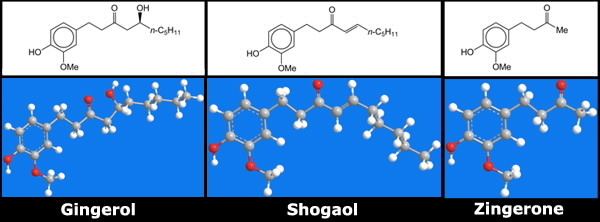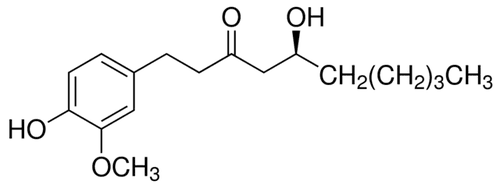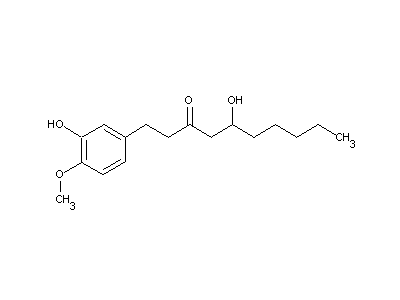Formula C17H26O4 | Molar mass 294.38 g/mol | |
 | ||
Gingerol, properly as [6]-gingerol, is the active constituent of fresh ginger. Chemically, gingerol is a relative of capsaicin and piperine, the compounds which give chilli peppers and black pepper their respective spicyness. It is normally found as a pungent yellow oil, but also can form a low-melting crystalline solid.
Contents

Cooking ginger transforms gingerol via a reverse aldol reaction into zingerone, which is less pungent and has a spicy-sweet aroma. When ginger is dried or mildly heated, gingerol undergoes a dehydration reaction forming shogaols, which are about twice as pungent as gingerol. This explains why dried ginger is more pungent than fresh ginger.
Ginger also contains 8-gingerol, 10-gingerol, and 12-gingerol, collectively deemed Gingerols.
Physiological effects
[6]-Gingerol administered by intraperitoneal injection has been used to induce a hypothermic state in rats.
Gingerol seems to be effective in an animal model of rheumatoid arthritis.

Gingerol and its analogues have a favourable toxicity profile, but are cytotoxic towards a range of cancer cell lines including blood cancer and lung cancer.

Gingerol has been investigated in vitro for its effect on cancerous tumors of the bowel, breast tissue, ovaries, and pancreas, with positive results.

The product is sometimes used for gingering of horses, a practice that is seen in the horse show world, and which is illegal in some, but not all disciplines.
Biosynthesis

Both ginger (Zingiber officinale) and turmeric (Curcuma longa) had been suspected to utilize phenylpropanoid pathway and produce putative type III polyketide synthase products based on the research of 6-gingerol biosynthesis by Denniff and Whiting in 1976 and by Schröder's research in 1997. 6-Gingerol is the major gingerol in ginger rhizomes and it possesses some interesting pharmacological activities like analgesic effect. While the biosynthesis of 6-gingerol is not fully elucidated, plausible pathways are presented here.

In the proposed biosynthetic pathway, Scheme 1, L-Phe (1) is used as the starting material. It is converted into Cinnamic acid (2) via phenylalanine ammonia lyase (PAL). Then it is turned into p-Coumaric acid (3) with use of cinnamate 4-hydroxylase (C4H). 4-coumarate:CoA ligase (4CL) is then used to get p-Coumaroyl-CoA (5). P-Coumaroyl shikimate transferase (CST) is the enzyme that is responsible for the bonding of shikimic acid and p-Coumaroyl-CoA. The complexed (5) is then selectively oxidized at C3 by p-coumaroyl 5-O-shikimate 3'-hydroxylase (CS3'H) to alcohol. With another action of CST, shikimate is broken off from this intermediate, thereby yielding Caffeoyl-CoA (7). In order to get desired substitution pattern on the aromatic ring, caffeoyl-CoA O-methyltransferase (CCOMT) converts the hydroxyl group at C3 into methoxy as seen in Feruloyl-CoA (8). Up until this step, according to Ramirez-Ahumada et al., the enzyme activities are very active. It is speculated that some polyketide synthases (PKS) and reductases are involved in final synthesis of 6-Gingerol (10).

Because it is unclear whether the methoxy group addition is performed prior or post to condensation step of the polyketide synthase, alternative pathway is shown in Scheme 2, where methoxy group is introduced after PKS activity. In this alternative pathway, the enzymes involved are likely to be cytochrome p450 hydroxylases, and S-adenosyl-L-methionine-dependent O-methyltransferases (OMT). There are three possibilities for the reduction step by Reductase: directly after PKS activity, after PKS and Hydroxylase activity, or in the end after PKS, Hydroxylase, and OMT activity.
